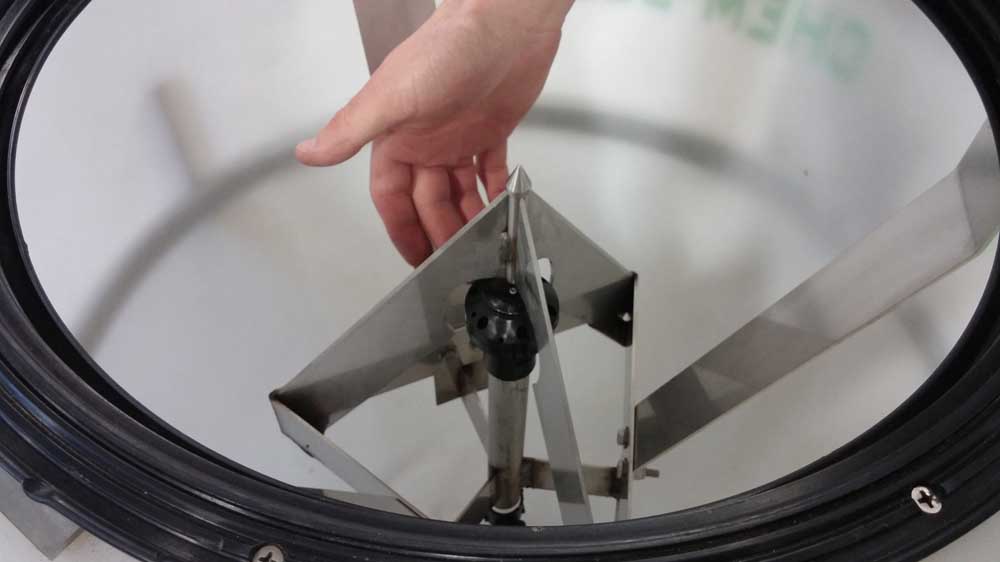Gadget a potential time-saver on the farm
Published 12:00 am Sunday, April 12, 2015

- Dan Voorhis / Wichita Eagle / TNSThe blades of the Chem-blade are designed to slice open the bottom of a plastic jug.
KINGMAN, Kan. — Ethan Eck remembers dumping agricultural chemicals into a farm sprayer as being kind of a pain in the rear.
If you’re doing it a few dozen times a day, and you’re supposed to rinse out and dispose of the jugs, too — and an expensive machine sits idling for the minutes it takes to complete those chores — then it’s more than an inconvenience. It’s an entrepreneurial opportunity.
That’s certainly what Eck and partner Ralph Lagergren hope. Eck, 23, is the inventor of the Chem-blade, a stainless steel gadget with blades that fits inside the plastic induction tank used to mix expensive farm chemicals such as pesticides and herbicides for farm sprayers. A farmer jams a plastic 2.5-gallon jug of herbicide onto the blades, which slice open the bottom, emptying the jug. A water jet then rinses the open jug.
Working out of a spacious metal building on the Eck family farm, north of this Wichita-area town, he and Lagergren have already developed a next generation Chem-blade, a powered version called the Chem-blade ES that received national attention earlier this year at the Commodity Classic farm show in Phoenix.
In the course of a day, the device might give farmers back 30 minutes, they said.
They have filed two patents so far and expect to file seven more.
So far Eck has sold about 500 of the original Chem-blade units, at about $550 each. They are hunting for licensees to manufacture the Chem-blade ES, so a unit is probably a year away from the market.
The market is there, he and Lagergren said. Spraying has replaced a lot of the mechanical tilling done to control weeds in fields because it’s faster, helps prevent erosion and can be better for the soil.
Their argument is farmers’ time has become so valuable that a farmer will spend a few thousand dollars for a gadget that empties a jug in half a second and then rinse it out. It ensures all of the chemical is used, that the farmer doesn’t get any on his hands or face and that he’s not violating environmental rules. A second unit will shred it.
“Spraying didn’t used to be that big a deal,” Lagergren said. “Now they can have 120-foot booms and travel 10 to 15 miles an hour. They can put down a lot of chemical.”
Whether to pursue a patent or other protection is a cost-benefit decision for the inventor, explains Crissa Cook, an intellectual property attorney.
Hiring an attorney to do patent research can cost several hundred dollars. Hiring an attorney to prepare the patent application can cost $8,000 to $10,000, plus a few thousand more to negotiate the final patent with the U.S. Patent and Trademark Office.
She recommends inventors do their own initial search, for free, at www.ustpo.gov or www.google.com/patents.
Eck has his own advice for inventors: They should think hard about revealing their invention to a person or team, so they can bounce design ideas off of them, ask for help in marketing, fundraising and legal work.
Eck had developed the Chem-blade about 18 months ago and had sold a few when he attended classes at the Kansas Small Business Development Center at Wichita State University. The center called Lagergren and asked him to talk to Eck to see if he could help. Initially reluctant, Lagergren got excited after he talked to Eck.
Eck said Lagergren’s strategic thinking and knowledge of marketing has dramatically changed the trajectory of the Chem-blade. He’ll get less per unit, but the prospects for selling a lot of them have gone way up.
“They treat it like their baby and won’t let anybody see it,” he said of an invention’s design. “It’s better because you’re a team.”
Lagergren said inventors have to embark on the journey to protect and commercialize their creations for the right reasons. “If they are only doing it for money, you’ll give up because it’s too hard,” he said. And he also cautioned against inventors’ unrealistic expectations.
“They’ll spend all their money on a patent and then sit back and wait for the checks to roll in,” he said. “Their biggest problem is getting it to market, not somebody stealing it.”






